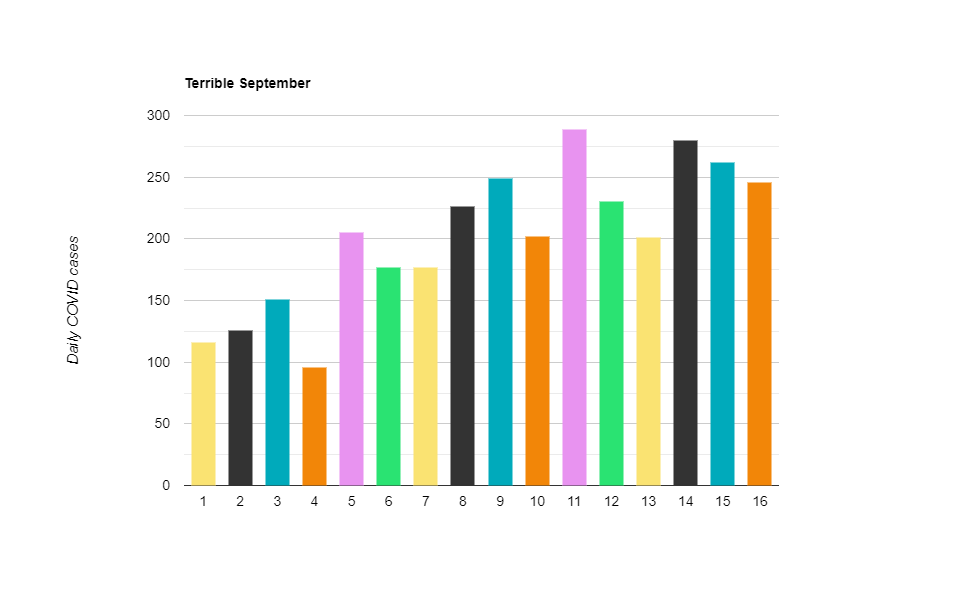SEPTEMBER is still halfway through and so is Baguio halfway through a COVID-19 nightmare.
Not only have the active cases reached more than 2,000 but the number of daily cases has far overshadowed the recovery rate.
This is also the “deadliest” month since Baguio recorded its first COVID-related death in March 2020.
From September 1 to 16, Baguio has recorded 69 deaths. The most number of deaths occured on September 15 when it recorded 12 deaths. The day before, there were ten deaths and on September 12 and 13, the city suffered seven deaths a day.
The 69 deaths account for 15 percent of all deaths recorded in Baguio since March 2020. As of September 16, Baguio has had a total of 412 COVID related deaths.
The worst surge before this was in April 2021 when Baguio recorded 48 deaths for the whole month. The 69 recorded this month was only up to September 16.
Baguio has recorded 3,233 cases so far this month. The highest total was on September 11 when it recorded 289 and on September 14 when it reached 280.
From September 9-16, Baguio recorded more than 200 cases a day. The only day that it didn’t reach 200 was on September 4, with 96 cases.
The average cases were more than 202 per day during the 16-day period.
Prior to this month, Baguio was maintaining an active COVID total cases of about 1,000. But on September 11, it reached 2,044.
The recoveries have been slow and few with only 1,333 during that same period. Its average recovery was only 88.625 cases a day.
Mayor Benjamin Magalong and City Health Officer Dr. Rowena Galpo said that based on the data and circumstances obtained in the city, the Delta variant appeared to have caused this surge.
From Sept. 7-14, the city’s average daily number of cases had reached 240, and the number of barangays with positive cases had gone up to 119 out of 128 or 92.25 percent.
Since the start of the surge in the last week of August, the city breached the 20,000-mark and posted a new single-day record of 289 cases last Sept. 11.
Galpo said the average daily attack rate and the two-week growth rate also climbed sharply at 35.3 (from 20.7) and 44 percent (from 19 percent), respectively.
The number of deaths also increased to two to three a day and had surpassed the daily average posted in April at the height of the Alpha and Beta surge.
Magalong said graphs that previously showed linear movement now reflect exponential rise. Moreover, statistics showed that the behavior of the surge is defying some conventions.
“We were expecting that with the restrictions we had adopted to limit the mobility of people, we could realize a downtrend by this time. But on the contrary, it has continued to increase. By that we can see that this variant is now defining the fundamentals of the COVID-19 fight,” the mayor said.
He said transmissions are now actively happening within homes and workplaces.
At present, the city has a total of 20 Delta variant cases identified by the Philippine Genome Center but since the PGC’s findings were not diagnostic but only for surveillance purposes, the city can expect more Delta cases in its midst, according to City Epidemiologist Dr. Donnabel Panes.
Link analysis and contact tracing of the first 13 Delta cases yielded a total of 732 linked patients.
“Based on the number of linked patients, we can assume na marami na ang Delta even if we only have 13 official ones. Besides, pumapalo ang cases natin in levels that we didn’t see even when we had Alpha and Beta indicative of Delta which is notorious in transmission kaya yung mga cases na hindi na-genome sequence, we can assume na Delta na sila ,” Panes said.
Panes said they have also observed an extraordinary increase in unlinked cases or patients who have had no links with known previous COVID positives which indicates active transmission going on in the community.
“Ang ibig sabihin po nito, hindi na natin alam ngayon kung saan nanggagaling at sino ang ang nakakahawa,” she said.
Mischelle Junio, lead contact tracing team data analyst, said data also showed how pervasive Delta is.
“Before only one or two members would get infected by the patient but now, almost everyone in the family gets it, including even the young ones. The same thing happens in workplaces, but worse, these workers bring the virus home to their own families and this is why our cases double or even triple,” Junio said.
The Delta variant has also defied the earlier established classification standards for contacts because before close contacts could only be declared as such if they have had a close encounter with patients within 15 or more minutes. Now, Delta has transcended the boundaries and time so that all persons who have had any encounter with the patient within the same time and space will now be considered close contacts.
Panes said the city can expect the surge to last depending on the control measures being implemented and the level of compliance with minimum public health standards.
“The virus is just waiting for the perfect time for us to let our guards down. Our efforts must be done both on the personal and collective levels for us to win over the virus,” she said. – Frank Cimatu and Aileen P. Refuerzo









